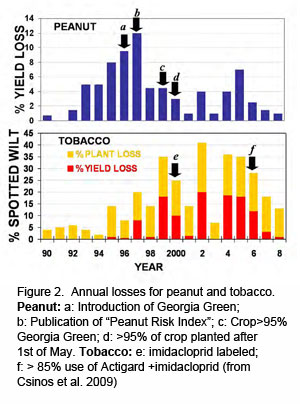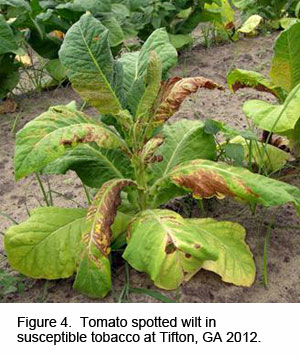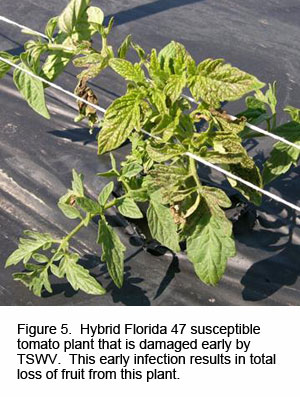History and Economic Impact
Tomato spotted wilt (TSW) in the USA was detected in peanuts in the USA (Texas) as early as 1974 (13) and field epidemics were reported in Texas by 1985 (3). Very early reports in Louisiana suggested that weeds were hosts of this virus (4). Also, it was noted very early in Louisiana that there was a possible link between the increase incidence of western flower thrips and TSW (11). In Alabama, TSW was reported in peanuts in 1988 (12) and by the 1990s TSW was reported as a serious problem in Georgia peanuts, breeding plants, vegetables, and tobacco (8,19.11,14, respectively), in multiple plant hosts in North Carolina (2,7), and in Virginia peanuts (16). The disease is caused by the Tomato spotted wilt virus (TSWV) which is vectored only by small insects called thrips. The two main thrips vector species associated with the above reports are the tobacco thrips, Frankliniella fusca(Hinds), and the western flower thrips, F. occidentalis (Pergande), both common thrips in the southeastern USA (18). The wide host range of both the virus and thrips vectors makes managing the disease very difficult. Based on 10 years of data from Georgia alone, an estimated annual average losses of $12.3 million in peanut, $11.3 million in tobacco and $9 million in tomato and pepper for a total of $326 million occurred from 1996-2006 (from UGA on line reports “Summary of Losses from Insect Damage and Costs of Control in Georgia” and “Georgia Plant Disease Loss Estimates”). If the recent losses in Georgia were representative of the remaining USA peanut acreage and one third of the remaining tobacco, pepper and tomato acreage, a conservative loss was estimated at $1.4 billion for the USA during this period.
 Peanut: Spotted wilt losses in peanut are based on a consensus estimate from each of the scientists (plant pathology, entomology and agronomy) involved in the annual evaluation of the spotted wilt risk index for peanut (5). Annual losses based on these estimates are shown in Fig. 2. The sharp declines in losses after 1997 are due to the implementation of a highly effective management program based principally on resistant varieties and planting date. Resistant varieties can reduce disease loss by 30%-75% for any planting date. Resistance-breaking strains of TSWV have not been found in peanut. However, the more current TSWV resistant peanut lines have better levels of resistance than those lines developed years ago. The loss cycle between 2001 and 2008, when the variety Georgia Green made up ~95% of the peanut acreage in Georgia, suggests partial resistance during this period and the resulting loss fluctuating with disease pressure. With partial resistance, other control tactics can become significant factors in mitigating the effects of this disease. For example, planting in May as opposed to April can result in a 40%-60% reduction of loss in susceptible to moderately resistant varieties. Other cultural practices offer additional additive disease reduction, particularly when April planting cannot be avoided (5, 6). In peanut, the use of quantifiable TSWV risk factors has become the standard approach for managing TSWV in other cropping systems and provides much of the foundation for the work done in this tomato-pepper project.
Peanut: Spotted wilt losses in peanut are based on a consensus estimate from each of the scientists (plant pathology, entomology and agronomy) involved in the annual evaluation of the spotted wilt risk index for peanut (5). Annual losses based on these estimates are shown in Fig. 2. The sharp declines in losses after 1997 are due to the implementation of a highly effective management program based principally on resistant varieties and planting date. Resistant varieties can reduce disease loss by 30%-75% for any planting date. Resistance-breaking strains of TSWV have not been found in peanut. However, the more current TSWV resistant peanut lines have better levels of resistance than those lines developed years ago. The loss cycle between 2001 and 2008, when the variety Georgia Green made up ~95% of the peanut acreage in Georgia, suggests partial resistance during this period and the resulting loss fluctuating with disease pressure. With partial resistance, other control tactics can become significant factors in mitigating the effects of this disease. For example, planting in May as opposed to April can result in a 40%-60% reduction of loss in susceptible to moderately resistant varieties. Other cultural practices offer additional additive disease reduction, particularly when April planting cannot be avoided (5, 6). In peanut, the use of quantifiable TSWV risk factors has become the standard approach for managing TSWV in other cropping systems and provides much of the foundation for the work done in this tomato-pepper project.
Tobacco: An example of spotted wilt damage in tobacco is shown in Fig. 4. The estimates for disease incidence (% plant loss) are based on disease evaluations in 10-60 on-farm trials per year, plus estimates from county agents not in the farm trial program, plus a final general estimate of plant loss from tobacco crop specialists.

The yield loss is estimated based on disease incidence figures. Tobacco shows a pattern of continued high loss after peanut losses declined sharply in 1998 (Fig. 2). Imidacloprid was labeled for managing spotted wilt in 2000. An imidacloprid insecticide treatment can reduce losses by 25%-30% and was used on 75%-80% of the tobacco by 2005. Actigard (chemically induced resistance) treatment of seedlings prior to transplanting was approved in 2003. A combination of Actigard followed by imidacloprid treatment of seedlings can reduce spotted wilt incidence by about 50%. This program gained acceptance slowly so that by 2006 ~85% of the Georgia crop was treated in this manner. Between 2000 and 2008, disease loss curves for treated (imidacloprid only or Actigard + imidacloprid) plants parallel, at a lower level, losses for untreated plants. Loss estimates in Fig. 2 take into account the relative portions of the crop untreated, treated with imidacloprid only, and treated with Actigard + imidacloprid. These portions are based on formal and informal surveys.
Vegetables: Tomato and pepper have been severely impacted by TSW in Georgia. Based on 10 years of data from Georgia alone, an estimated annual average loss of $9 million in tomato and pepper occurred from 1996-2006 (from UGA on line reports “Summary of  Losses from Insect Damage and Costs of Control in Georgia” and “Georgia Plant Disease Loss Estimates” summarized in 18). Losses as high as 95% in spring-grown susceptible tomatoes have been observed at individual sites during the above time period. Early attempt at control consisted of imidacloprid treatment as a seedling drench, foliar insecticides and reflective mulch, but the resistant tomato cultivar, Stevens, was not acceptable to commercial tomato producers (17). However, by 2008, the use of high quality TSW-resistant commercial lines of tomato and pepper was becoming widespread. The current impact of this disease has been greatly diminished with tomato and pepper commercial lines that are resistant to TSW. Also, important for long term control are the other tactics such as reflective mulch and chemical treatments discussed in this web site.
Losses from Insect Damage and Costs of Control in Georgia” and “Georgia Plant Disease Loss Estimates” summarized in 18). Losses as high as 95% in spring-grown susceptible tomatoes have been observed at individual sites during the above time period. Early attempt at control consisted of imidacloprid treatment as a seedling drench, foliar insecticides and reflective mulch, but the resistant tomato cultivar, Stevens, was not acceptable to commercial tomato producers (17). However, by 2008, the use of high quality TSW-resistant commercial lines of tomato and pepper was becoming widespread. The current impact of this disease has been greatly diminished with tomato and pepper commercial lines that are resistant to TSW. Also, important for long term control are the other tactics such as reflective mulch and chemical treatments discussed in this web site.
Based on vegetable grower surveys in 2008-2009 in Georgia, Florida, South Carolina and North Carolina, 75% of tomato growers and 58% of pepper growers use at least some improved method (e.g. resistant cultivar, metallic reflective-mulch, Actiguard, imidacloprid) in managing TSWV. Over 67% of tomato growers used some TSWV-resistant tomato variety and imidacloprid while 60% reported using Actiguard. Fewer tomato (19%) and pepper (16%) growers appear to be using reflective metallic-mulch). Most of the respondents (71%) indicated that TSWV- Resistant varieties reduces TSW and produce fruits of acceptable yield and quality. Over half of the respondents (62%) indicated having problems with more than one virus in tomato production while only 36% of them face a similar problem with pepper. Statistical analysis revealed that the odds that growers were satisfied with the use of Actiguard alone in controlling TSWV is 7 to 1 while the odds that growers were satisfied with the use of reflective mulch alone is 9 to 1 as opposed to not using each of the tactics. The odds that growers were satisfied using a combination of Actiguard and reflective mulch in the control of TSWV was 59 to 1 as opposed to not using both (1).
A cost-benefit analysis comparing improved management practices (IMP) with conventional management practices (CMP) using results from on-station experiments and costs (fixed, variable) data revealed a nominal total cost of production of $11,013/ac for the CMP and $13,314/ac for IMP. A break-even (BE) variable cost of $2.88 and $2.33 was estimated for CMP and IMP respectively and a BE yield of $1,366 cartons/ac (25 lbs) for CMP and $1,664 cartons/ac (25 lbs) for IMP was determined. Considering the margin of error in the estimates (using a risk rated sensitivity analysis), the results of Table 1 below indicate that the increase in yield and net return from using IMP are large enough to compensate tomato growers for the additional cost of production incurred in using IMP (9).
Table 1. Risk-rated sensitivity analysis of producing tomatoes using CMS and TSWV Management techniques in the Southeast, USA, 2009.
| Best | Optimistic | Median | Pessimistic | Worst | |
| TSWV Returns 1/ Conv Returns 2/ |
$6,052 $3,645 |
$3,882 $1,926 |
$2,798 $1,067 |
$1,713 $207 |
$-456 $-1,512 |
| Risk-rated % Chances | 7% | 31% | 50% | 31% | 7% |
| Chances of Profit | TSWV CMS |
90% 73% |
Net Revenue | TSWV CMS |
$2,798 $1,067 |
1/ Conventional management strategy (CMS) risk-rated sensitivity costs.
2/ Thrips and Tomato Spotted Wilt management (TSWV) risk-rated sensitivity costs.
Most commercial tomato farmers in regions of the Southeast where TSW is a known problem currently use tomato cultivars with host plant resistance to the virus that caused TSW. Thus, the new CMS (above table) is quickly becoming the TSWV management program in these areas. Marketing and trade will continue to be a major influence on choices made by the tomato growers in the Southeastern USA and economics will ultimately decide if the industry can adapt to this and other threats to production. At present, it appears that economical solutions to this TSW disease problem will prevail in vegetable crops.
Authors: D. Riley, G. Fonsah, S. Awondo, A. Csinos, N. Martinez-Ochoa, P. Bertrand, J. M. Moore, and A. Culbreath
References
- Awondo, S.N., E. G. Fonsah, D.G. Riley, and M. Abney. 2011. Stated effectiveness of Tomato spotted wilt virus management tactics. J. Econ. Entomol. 105: 943–948.
- Barbour, J.D., and R.L. Brandenburg. 1994. Vernal infusion of thrips into North Carolina peanut fields. J. Econ. Entomol. 87: 446-451.
- Black, M.C., P.F. Lummus, D.H. Smith, and J.W. Demski. 1986. An epidemic of spotted wilt disease in south Texas peanuts in 1985. Proc. Am. Peanut Res. Ed. Soc. 18: 66-66.
- Bond, W.P., H.K. Whitman and L.L. Black. 1983. Indigenous weeds as reservoirs of Tomato spotted wilt virus in Louisiana. Phytopathology 73: 499-499.
- Brown, S.L., J.W. Todd, A.K. Culbreath J.A. Baldwin, J.P. Beasley and H.R. Pappu. 1999. The Tomato Spotted Wilt Risk Index – Identifying and avoiding high risk situations. Univ. of Georgia Coop. Ext. Bull. 1165, Athens, GA.
- Brown, Steve L., A. K. Culbreath, J. W. Todd, D. W. Gorbet, John A. Baldwin, and John P. Beasley, Jr. 2005. Development of a method of risk assessment to facilitate integrated management of spotted wilt of peanut. Plant Dis. 89: 348-356.
- Cho, K.J., C.S. Eckel, J.F Walgenbach, and G.G. Kennedy. 1995. Overwintering of thrips (Thysanoptera, Thripidae) in North Carolina. Environ. Entomol. 24: 58-67.
- Culbreath, A.K., A.S. Csinos, P.F. Bertrand, and J.W. Demski. 1991. Tomato spotted wilt virus epidemic in flue cured tobacco in Georgia. Plant Dis. 75: 483-485.
- Fonsah, E. G., C.M. Ferrer, D. G. Riley, S. Sparks and David Langston. 2010. Cost and Benefit Analysis of Tomato Spotted Wilt Virus (TSWV) Management Technology in Georgia. The Southern Agricultural Economic Association Conference (SAEA) website
- Gitaitus, R.D., C.C. Dowler, and R.B. Chalfant. 1998. Epidemiology of tomato spotted wilt in pepper and tomato in southern Georgia. Plant Dis. 82:752-756.
- Greenough, D.R., L.L. Black, R.N. Story, L.D. Newsom, W.P. Bond. 1985. Occurrence of Frankliniella occidentalis in Louisiana – A possible cause for the increased incidence of Tomato spotted wilt virus.
- Gudauskas, R.T., A.K. Hagan, J.R. Weeks, R.A. Shelby, W.S. Gazaway, and J.C. French. 1988. Incidence of tomato spotted wilt in peanuts in Alabama USA. Phytopathology 78: 1564-1564.
- Halliwel, R.S. and G. Philley. 1974. Spotted wilt of peanut in Texas. Plant Dis. Reporter 58: 23-25.
- McPherson, R.M., R.J. Beshear, and A.K. Culbreath. 1992. Seasonal abundance of thrips (Thysanoptera, suborders Terebrantia and Tubulifera) in Georgia flue-cured tobacco and impact of management-practices on the incidence of Tomato spotted wilt virus. J. Entomol. Sci. 27: 257-268.
- NASS. 2012. Vegetables 2011 Summary (January 2012). USDA, 89 pp.
- Porter, D.M., J.W. Demski, and P.M. Phipps. 1991. First report of Tomato spotted wilt virus in peanut in Virginia. APSnet Plant Dis. Note. DOI:10.1094/PD-75-0431C
- Riley, D. G. and H Pappu. 2000. Evaluation of tactics for management of thrips - vectored tomato spotted wilt Tospovirus in tomato. Plant Dis. 84: 847-852.
- Riley, D. G., S. V. Joseph, R. Srinivasan, and S. Diffie. 2011. Thrips vectors of tospoviruses. J. Integ. Pest Mngmt. 1(2): 2011, DOI: 10.1603/IPM10020.
- Ruter, J.M. and R.D. Gitaitus. 1993. First report of Tomato spotted wilt virus in bedding plants in Georgia. Plant Dis. DOI: 10.1094/PD-77-0101D.
